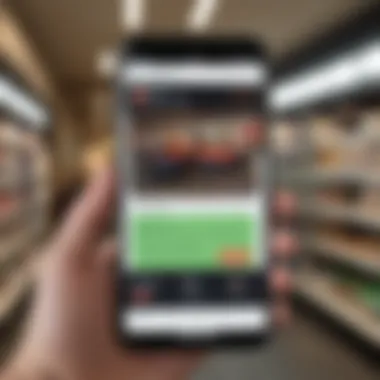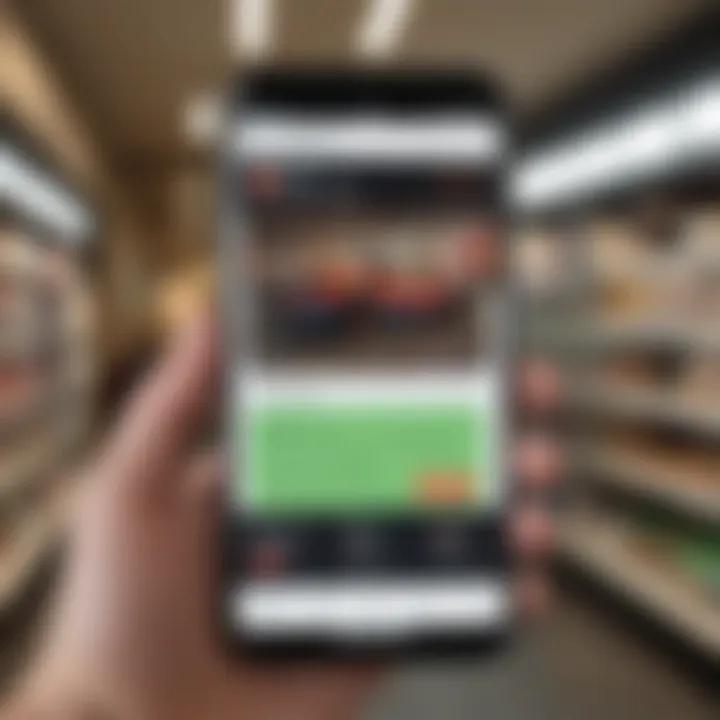Exploring the Scan & Go App: Transforming Retail Experience


Intro
In recent years, retail has experienced immense transformation, driven by the integration of technology into the daily shopping experience. The Scan & Go app serves as a prime example of this evolution, combining convenience and efficiency to reshape consumer behavior. The app allows shoppers to scan items as they shop, streamlining the checkout process and enhancing user satisfaction.
As consumers demand more from their shopping experiences, understanding the functionalities, benefits, and potential drawbacks of the Scan & Go app is essential. This exploration seeks to provide valuable insights into how this technology not only benefits individual shoppers but also influences the broader retail market. By examining the intricacies of this app, its security features, and overall impact, the reader will gain a comprehensive understanding of its significance in contemporary retail.
Market Overview
The retail sector is witnessing rapid changes, particularly with the rise of mobile applications like Scan & Go. These changes reflect significant trends that are redefining how consumers interact with brands and make purchases.
Current Market Trends
In the current retail landscape, mobile technology is prevalent. Many consumers prefer using smartphones for shopping due to convenience. Trends show an increase in mobile commerce, with many retailers investing in mobile apps to enhance customer engagement and service delivery.
Key Market Indices Performance
The performance of market indices plays a crucial role in understanding the retail sector's health. Indices such as the S&P 500 or specific retail indexes can reflect how technology-driven strategies like Scan & Go affect overall market performance. Understanding these indices guides investors in assessing the economic environment.
Economic Factors Influencing the Market
Several economic factors impact the retail industry significantly. Changes in disposable income, consumer confidence, and employment rates influence shopping behaviors. Additionally, advancing technology and infrastructure improvements lead to higher adoption rates of applications like Scan & Go.
Sector Spotlight: Leading Sectors Affected by Trend
The grocery and retail sectors are the most impacted by the rise of technological solutions like the Scan & Go app. Supermarkets, convenience stores, and large retailers are rapidly adapting to consumer demands for quicker, more efficient shopping experiences. This sector's adaptability is crucial for maintaining competitiveness in the market.
The integration of technology in retail is not merely a trend; it represents a fundamental shift in consumer shopping habits and expectations.
User Experiences and Benefits
Understanding user experience is vital to gauge the app's effectiveness. The Scan & Go app allows shoppers to enjoy a personalized and seamless shopping journey. The primary benefits include:
- Efficiency: Shoppers can scan items on their own, significantly reducing time spent in checkout lines.
- Customization: Users can create shopping lists and navigate stores more effectively.
- Transaction Transparency: Customers can see the total cost of items before completing the purchase.
By enhancing convenience and offering more control, the Scan & Go app aligns with modern consumer expectations.
Challenges and Security Concerns
While the app offers numerous benefits, it also brings challenges. One key concern is the need for robust security measures. Personal data, payment information, and shopping habits are sensitive. If compromised, this data can have severe consequences for consumers and retailers alike.
Prelude to Scan & Go Technology
The integration of technology in retail has become a pivotal aspect of consumer experience. Scan & Go technology stands out as a significant advancement. It has revolutionized how consumers engage with brick-and-mortar stores. This introduction focuses on the essence of Scan & Go technology, highlighting its influence on shopping patterns and consumer behavior.
Definition and Overview
Scan & Go technology refers to a shopping method that allows customers to use a mobile app to scan items as they shop. This capability enables customers to keep track of their total and streamline checkout. Typically, after scanning all their items, shoppers can simply pay via the app and exit the store without waiting in line. This method reflects a blend of convenience and efficiency that has become increasingly important in today’s fast-paced lifestyle.
The significance of Scan & Go lies in its ability to create a frictionless shopping experience. By providing an interactive platform, it helps retailers keep pace with customer expectations for quick service and accessibility. Users can shop at their own speed. This autonomy in the shopping process enhances overall satisfaction, making it a desirable feature among modern consumers.
History of Scan & Go Development


The development of Scan & Go technology can be traced back to the early 2000s. Retailers began experimenting with self-checkout systems. However, initial implementations of these systems had limitations. They often required the use of in-store kiosks, which still involved waiting in line. Customers expressed frustration over the slow checkout processes.
In the late 2010s, technological advances in mobile apps and barcode scanning ushered in a new era for retail. Retail giants, such as Walmart and Amazon, recognized the potential of mobile-enabled shopping solutions. They began to develop applications that empowered consumers to scan items directly. The introduction of dedicated mobile grocery apps marked a turning point in retail innovation.
Subsequently, the quick adaptation of smartphones among shoppers contributed significantly to the success of Scan & Go. As many people were already using their devices for various tasks, integrating shopping into this ecosystem felt natural. Today, Scan & Go technology continues to evolve, aligning with emerging digital trends in the retail sector, and remains a focal point of ongoing development and consumer engagement.
Functionalities of Scan & Go Apps
The functionalities of Scan & Go apps are critical in defining how they reshape the shopping experience. These applications provide features that streamline the purchasing process through digital means. The integration of modern technology allows shoppers to engage with retail spaces in a personalized way. Here, we will detail specific functionalities such as scanning and checkout features, user interface and experience, and integration with loyalty programs.
Scanning and Checkout Features
The most fundamental aspect of the Scan & Go app is its scanning and checkout capabilities. Shoppers use their smartphones to scan items as they shop. This capability eliminates the traditional checkout line, enabling a seamless transaction at the end of the shopping experience.
- Real-Time Item Scanning: Users can see the prices of items in real-time. This transparency can aid in budget management, allowing shoppers to make informed decisions about their purchases.
- Simplified Payment Process: After scanning, users complete their purchase directly through the app. This function can save time and create a more pleasant shopping experience. By using various payment methods such as credit cards or mobile wallets, user convenience is further enhanced.
This functionality not only improves efficiency but also enables shoppers to engage with the retail space without the usual frustrations associated with traditional shopping methods.
User Interface and Experience
The user interface of Scan & Go apps plays a significant role in user satisfaction. A well-designed interface can greatly influence how consumers perceive the app and impacts their willingness to use it consistently.
- Intuitive Navigation: An effective app provides a streamlined navigation path. Features like easy access to scanned items, a clear summary of purchases, and visible pricing allow users to manage their shopping experience effortlessly.
- Visual Design: A clean and attractive design enhances user engagement. Utilizing simple yet effective graphics can help users feel comfortable while using the app. A user-friendly design retains consumer interest and enhances satisfaction with the shopping process.
When the user experience is prioritized, it encourages more frequent use of the Scan & Go app, fostering a blend between technology and daily shopping habits.
Integration with Loyalty Programs
The integration of loyalty programs with Scan & Go apps is another essential functionality. Many retailers have loyalty structures that reward repeat customers, and incorporating these into the app can significantly boost shopper engagement.
- Points Accumulation: As users scan and shop, points can be automatically added to their loyalty accounts. This immediate feedback reinforces customer loyalty as shoppers see tangible benefits from using the app.
- Personalized Discounts: Scanning can trigger personalized offers based on previous shopping habits. Tailoring discounts to individual users further increases the likelihood of repeat purchases, ensuring that the retailer retains customers.
By linking loyalty programs with Scan & Go apps, the experience shifts from merely transactional to a more personalized, value-rich engagement.
The functionalities of Scan & Go apps serve as a gateway to a more efficient shopping experience, intertwining advanced technology with consumer expectations for convenience and personalization.
Advantages of Using Scan & Go Apps
The increasing use of Scan & Go apps in retail demonstrates how technology enhances customer experiences. These applications have altered the shopping landscape, making it imperative to discuss their advantages. Understanding these benefits is essential for retailers and customers alike, as they navigate a world where convenience and efficiency are paramount.
Enhanced Convenience for Shoppers
Scan & Go apps provide a level of convenience that traditional shopping lacks. Consumers can scan items as they shop, which allows them to keep track of their expenses and avoid long checkout lines. This flexibility is particularly appealing for busy individuals who value time efficiency. Using such apps, shoppers can shop at their own pace, without the pressure of waiting in line.
Additionally, many of these apps store payment information, further simplifying the process. Users can complete their purchases quickly and easily, often just by walking out of the store. This seamless integration of scanning and payment processes results in a more enjoyable shopping experience. This convenience can lead to increased customer loyalty as well, since satisfied shoppers are likely to return.
Time Efficiency and Reduced Wait Times
One of the standout benefits of Scan & Go apps is their ability to reduce wait times significantly. Traditional shopping experiences often involve lengthy lines, which can be frustrating and time-consuming. With Scan & Go, customers can bypass these queues entirely.
As shoppers scan items in their cart, they can pay directly through the app, allowing for an uninterrupted shopping flow. This functionality not only saves time for consumers, but it can also enable retailers to serve more customers in a given time frame, optimizing their operations. With a reduction in time spent waiting, customer satisfaction typically increases, which positively influences store reputation and sales.
Quick checkouts lead to more sales and happier customers.


Data-Driven Shopping Insights
Another significant advantage of using Scan & Go apps is the opportunity for retailers to gather valuable data. These applications collect information on consumer behavior, preferences, and purchasing patterns. This data is crucial for retailers looking to improve their offerings and marketing strategies.
By analyzing this information, businesses can tailor promotions and inventory to meet the specific needs of their customers. Insights gained from this data can inform product placement, future inventory decisions, and even personalized marketing efforts. For consumers, this means a more tailored shopping experience, as retailers can offer relevant suggestions based on past purchases. Data-driven strategies represent a forward-thinking approach for retailers aiming to compete in a crowded market.
Challenges and Limitations
The rise of the Scan & Go app represents a significant shift in consumer retail behavior. However, this innovation is not without its challenges and limitations. Understanding these hurdles is essential for both consumers and retailers who aim to navigate this evolving landscape effectively.
Technical Issues and User Errors
Technical problems can disrupt the shopping experience with Scan & Go. Common issues include app crashes, slow loading times, and failure to scan products accurately. Such technical difficulties can lead to frustration and decreased user satisfaction. Furthermore, user errors are prevalent, particularly among those who are not technologically savvy. Mistakes may occur during the scanning process or when completing transactions. These errors can result in longer wait times and create a negative perception of the app's efficiency.
Retailers need to prioritize regular updates and provide reliable customer support to mitigate these technical challenges. Encouraging user education can also help in minimizing errors, ensuring a smoother experience overall.
Security and Privacy Concerns
Security and privacy are significant considerations for the adoption of the Scan & Go app. Many consumers worry about the safety of their data, particularly sensitive financial information. Data breaches can lead to identity theft, which may deter users from embracing this technology. Retailers must implement robust security measures to protect user data and build trust with their customers.
Additionally, transparency about how data is collected, used, and stored is crucial. Users should be informed of their rights regarding personal information and the steps retailers take to safeguard their privacy. Establishing a strong commitment to data protection can alleviate concerns and promote wider acceptance of the Scan & Go app.
Adoption Barriers Among Consumers
Despite the benefits, numerous barriers exist that hinder widespread adoption of Scan & Go apps. Familiarity with technology plays a large role; some consumers, particularly older adults, may find it intimidating to adopt new technology. Lack of access to smartphones or stable internet connection can also pose obstacles.
Socio-economic factors contribute to these barriers as well. In some communities, there is limited exposure to digital payment methods and technology-driven shopping. Retailers must address these challenges by offering support and education to all segments of their customer base.
Additionally, stores can introduce incentives, such as discounts or loyalty points, to encourage users to explore the benefits of Scan & Go technology. Addressing these adoption barriers is essential to enhance user acceptance and integrate this innovative shopping method into everyday retail experiences.
The successful integration of Scan & Go technology in retail hinges on overcoming these key challenges and limitations.
Consumer Behavior and the Scan & Go Experience
Understanding consumer behavior in relation to the Scan & Go experience is essential. This relationship reveals how shoppers interact with the technology, their preferences, and the unforeseen challenges that may arise during use. The app introduces convenience, but also asks consumers to adapt to new shopping practices.
Demographic Insights
Demographics play a key role in how the Scan & Go app is received and utilized. Different age groups have varying levels of comfort with mobile technology. For instance, younger shoppers are often more adept at navigating apps and may show greater enthusiasm for adopting new technologies. In contrast, older generations might be hesitant or prefer traditional shopping methods.
Several studies indicate that Millennials and Gen Z shoppers are more likely to embrace the Scan & Go experience. Their familiarity with digital transactions aligns with the seamless nature of the app. Additionally, consumers in urban areas tend to adopt the technology more readily than those in rural settings. This disparity can be attributed to a higher density of stores and a greater emphasis on convenience in fast-paced environments.
User Adoption Trends
Analyzing user adoption trends reveals critical insights into the success of the Scan & Go app. Initially, adoption may be sluggish in new markets, but as awareness grows, so does usage. Early adopters typically share their experiences on social media platforms like Facebook and Reddit, which can either motivate or deter others. Positive feedback often leads to increased downloads and usage.
The overall trend indicates a gradual shift towards a preference for self-checkout experiences. Shoppers appreciate the ability to manage their purchases independently, reducing reliance on store staff. Retailers are adapting to these shifts by investing in app enhancements and marketing strategies that appeal to tech-savvy consumers.
The Scan & Go technology has the potential to redefine how consumers approach shopping, leading to a more personalized and efficient experience.
Impact on Retailers and the Market
The advent of the Scan & Go app represents a significant development within the retail sector. It has made an indelible mark on how stores conduct operations and interact with customers. Understanding this impact is essential for recognizing the transformative nature of retail technology today.


Changes in Store Operations
The Scan & Go app fundamentally alters store operations by streamlining the checkout process. Traditional cash registers often create bottlenecks during peak shopping hours. In contrast, Scan & Go apps allow customers to scan items as they shop, thereby minimizing the need for lengthy queues. This enhancement leads to reduced labor costs, less pressure on staff, and ultimately results in a faster, more efficient shopping experience.
Staff can be redeployed to assist customers within the aisles or manage other critical operations rather than focusing predominantly on the checkout area. Moreover, stores harness valuable data from the app usage, allowing better inventory management. Retailers can quickly identify top-selling items and adjust stock accordingly. This responsiveness not only meets customer demand more swiftly but also helps in reducing waste from unsold products.
Shifts in Competitive Landscape
The integration of Scan & Go technology influences the competitive landscape of the retail market. Businesses that adopt such technology can differentiate themselves by providing enhanced customer experiences. This is crucial in a crowded market where consumer preferences are rapidly changing. As retailers innovate with tech like Scan & Go, they set new standards for service that competitors feel pressured to meet.
Adopting this technology may not only attract initial customers but also foster loyalty. Customers often favor retailers that provide more control and choice during their shopping experience. As a result, retailers who do not adapt may risk obsolescence.
"Retailers must adapt to new technologies to remain relevant in an evolving market."
The influence extends beyond established players as well. New entrants equipped with innovative tools can swiftly capture market share, challenging traditional retail giants. Therefore, it becomes increasingly important for established stores to embrace technological advancements to maintain a competitive edge.
Future of Scan & Go Apps
The future of Scan & Go apps stands as a critical aspect of modern shopping technology. As consumer behaviors change and technological advancements accelerate, these apps will likely evolve significantly. Understanding future trends is important not only for retailers but also for consumers and technology enthusiasts. There are several key elements to consider, including technological innovations and market expansion that will shape the future landscape of Scan & Go apps.
Technological Innovations on the Horizon
Technological innovations will be pivotal in defining the future of Scan & Go applications. Continuous advancements in mobile technology, artificial intelligence, and secure payment systems are vital. Among the most promising developments is the integration of machine learning to enhance user experience. This could lead to personalized shopping suggestions based on purchase history and preferences.
Another area of innovation involves using augmented reality. Retailers may eventually enable customers to scan items in real-time using their smartphones, displaying product details, prices, and relevant promotions. This could enrich the shopping experience and streamline decision-making processes.
Blockchain technology also presents opportunities for increased security in transactions. As concerns about data privacy grow, using decentralized ledgers can enhance customer trust. With better security measures, more customers may feel comfortable adopting Scan & Go options in their shopping routines.
Moreover, the future may witness the rise of contactless payments and biometric verification. These technologies would significantly reduce checkout waiting times, ultimately improving overall customer satisfaction.
Potential Expansion into New Markets
The potential expansion of Scan & Go apps into new markets is notable. As retailers look to attract diverse consumer segments, regions with emerging markets represent a significant opportunity. Places with growing smartphone penetration and increasing digital literacy are suitable candidates for Scan & Go app implementation.
Furthermore, industries outside traditional grocery stores may adopt these technologies. For instance, fashion retailers and electronics stores could implement similar systems to facilitate faster transactions and improve the shopping experience. This adaptability can help retailers stay competitive.
Additionally, Scan & Go technology can improve accessibility for all shoppers. When integrated into small businesses, it can provide a seamless shopping experience that might not require extensive staffing.
To summarize, the future of Scan & Go apps exists at the intersection of technology and consumer demand. Organizations that leverage emerging tech and explore new markets are poised to lead in this evolving landscape. Developing user-friendly and efficient applications will be essential to meet consumers' expectations and redefine the shopping experience.
"The future of retail belongs to those who embrace technology and adapt to consumer behaviors."
The End
The conclusion of this article serves as an essential synthesis of the insights gained from exploring the Scan & Go app. It highlights the crucial role that such technologies play not only in reshaping shopper experiences but also in redefining retail operations themselves.
A key point to consider is the increasing demand for efficiency in shopping. Modern consumers expect fast transactions and reduced waiting times, a feature that the Scan & Go app satisfies. This demand is attributed to the fast-paced lifestyle many people lead today, necessitating innovative solutions that technology can provide.
Moreover, the analysis of the challenges and limitations that accompany the adoption of Scan & Go technologies draws attention to the complexities involved in transitioning from traditional methods to digital experiences. Security concerns and technical issues remain paramount, requiring thoughtful solutions from both developers and retailers.
In summary, the role of Scan & Go technology is profound, impacting various aspects of the shopping landscape. As retailers and developers work to refine these apps, they must consider user feedback and emerging trends to ensure broad acceptance among consumers. The Scan & Go app is not merely a convenience but an indication of where retail is headed—toward greater integration of technology designed to enhance customer engagement.
Summary of Key Points
- The Scan & Go app streamlines the shopping experience by facilitating quick transactions.
- Users may face technical issues and security concerns that need addressing.
- The continuing evolution of these apps could lead to further adoption and acceptance among consumers.
- Retailers must adapt to changing landscapes to remain competitive in a tech-driven market.
Final Thoughts on Scan & Go Integration
Integrating Scan & Go apps into retail environments represents a significant shift in how consumers interact with products and services. While the technology promises numerous benefits, it also presents challenges that cannot be overlooked. Retailers must navigate these challenges effectively to harness the full potential of the Scan & Go experience. Future iterations of Scan & Go technology may incorporate advancements such as augmented reality shopping experiences or enhanced security measures to address current limitations. As these technologies evolve, they will not only drive revenue for retailers but also improve customer satisfaction by making the shopping process more enjoyable and efficient.







